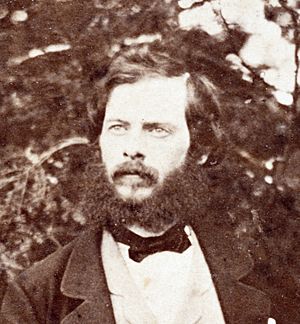Theodore Winthrop facts for kids
Quick facts for kids
Theodore Winthrop
|
|
|---|---|
 |
|
| Born | September 22, 1828 New Haven, Connecticut |
| Died | June 10, 1861 (aged 32) |
| Signature | |
Theodore Woolsey Winthrop (born September 22, 1828 – died June 10, 1861) was an American writer, lawyer, and world traveler. He is remembered as one of the first officers from the Union Army to be killed during the American Civil War.
Early Life and Adventures
Theodore Winthrop was born in New Haven, Connecticut. He came from important early American families. His family included Governor John Winthrop and the famous thinker Jonathan Edwards.
He went to Yale University and graduated in 1848. After college, he spent a year traveling in Great Britain and Europe. He then explored different parts of the United States. In the 1850s, he settled in Staten Island, New York.
Joining the Union Army
Before the war, Winthrop wrote short stories and articles for magazines. These did not get much attention at first. When the Civil War began in 1861, President Abraham Lincoln asked for soldiers. Winthrop joined the 7th New York Militia, which was one of the first volunteer units.
He wrote a popular essay about his experience called "Our March to Washington." Soon after, he became a Major and an assistant (called an aide-de-camp) to Major General Benjamin Butler. General Butler was in charge of the Union forces in Virginia.
Winthrop strongly believed that slavery should be ended. He helped General Butler create a rule that said enslaved people who escaped and reached Union Army areas would automatically be free.
Battle of Big Bethel
On June 10, 1861, a battle took place at Battle of Big Bethel. Major Winthrop volunteered to help General Ebenezer W. Peirce plan the fight. He drew up a rough plan for the battle.
During the battle, the Union attack on the Confederate side failed. Winthrop then bravely led an attack on the other side of the Confederate lines. This area was held by soldiers from the 1st North Carolina Infantry Regiment.
In the middle of the fighting, Major Winthrop jumped onto a fallen tree. He reportedly shouted, "One more charge boys, and the day is ours!" Soon after, he was shot in the heart by a musket ball. He died, becoming the first high-ranking officer from the Northern side to be killed in the Civil War. Several Confederate soldiers claimed to have shot him.
A Writer's Legacy
Theodore Winthrop wrote several novels, but he could not find a publisher for them during his lifetime. After his death, his books were finally published.
Some of his famous novels include:
- John Brent: This book was based on his adventures in the American West.
- Edwin Brothertoft: This was a story set during the American Revolution.
- Cecil Dreeme: This was his most important work. It was a novel about social rules and gender roles, set at New York University.
Other works he wrote include The Canoe and the Saddle and Life in the Open Air. His sister, Laura Winthrop Johnson, put together a collection of his poems and writings.
During his life, Winthrop also wrote a pamphlet for a painting called The Heart of the Andes. This painting was by his friend Frederic Edwin Church. After Winthrop died, a magazine called Atlantic Monthly published some of his writings about military campaigns in Virginia.

